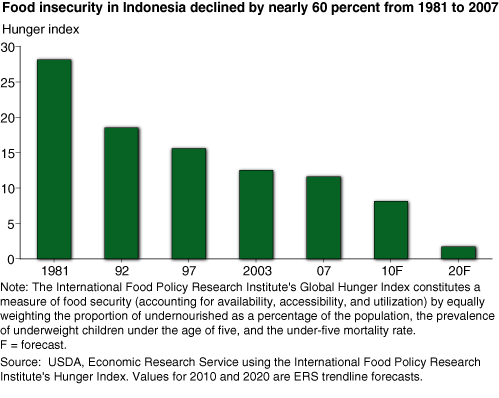Indonesian Agricultural Growth Leads to Increased Trade and Food Security
- by Nicholas Rada
- 6/1/2010
Indonesian policy changes in the mid-1980s and mid-1990s provided incentives for agricultural producers to exploit the country’s comparative advantage in tropical perennial crops. Rising Indonesian agricultural exports contributed to improving per capita wealth. As Indonesian consumer demand amplified for high-value foods, U.S. agricultural export values to Indonesia between 2008 and 2009 rose an average annual 25 percent for fresh fruit items, 39 percent for dairy products, and 30 percent for feed and fodder.
During the 1970s, the Indonesian Government focused agricultural research on “Green Revolution” seed-fertilizer technology and provided subsidies to boost agricultural yields. By the mid-1980s, Indonesia was nearly self-sufficient in rice production but heavily dependent on oil and natural gas for export earnings. In response, the Government shifted toward an industrial and export-led development strategy. Indonesia’s market reorientation, coupled with the lifting of trade disincentives and sharp currency devaluation following the Asian financial crisis, spurred an 11-percent and 7-percent average annual increase in Indonesia’s agricultural export and import values, respectively, between 1998 and 2007.
ERS researchers found that agricultural productivity growth stagnated following Indonesia’s agricultural realignment in the mid-1980s but then improved significantly after the Asian financial crisis. Under the more export-oriented development strategy, productivity growth was higher for perennial (export) crops—driven largely by growth in palm oil production—than for livestock and annual (food) crops.
Despite Indonesia diversifying away from food crops, food insecurity there declined by nearly 60 percent from 1981 to 2007, driven largely by increased food access and higher incomes. Food security is generally defined as sufficient availability of food (2,100 calories per person per day) that is readily accessible (physically available and affordable) and utilized (nutrient consumption and absorption). Indonesia boosted food availability through agricultural growth and food imports, but increasing food availability was not the sole factor contributing to its improved food security. Indonesia’s expansion of food accessibility through greater consumer purchasing power and mobility of goods and services likely has played a significant role.
This article is drawn from:
- Rada, N. & Regmi, A. (2010). Trade and Food Security Implications From the Indonesian Agricultural Experience. U.S. Department of Agriculture, Economic Research Service. WRS-10-01.


